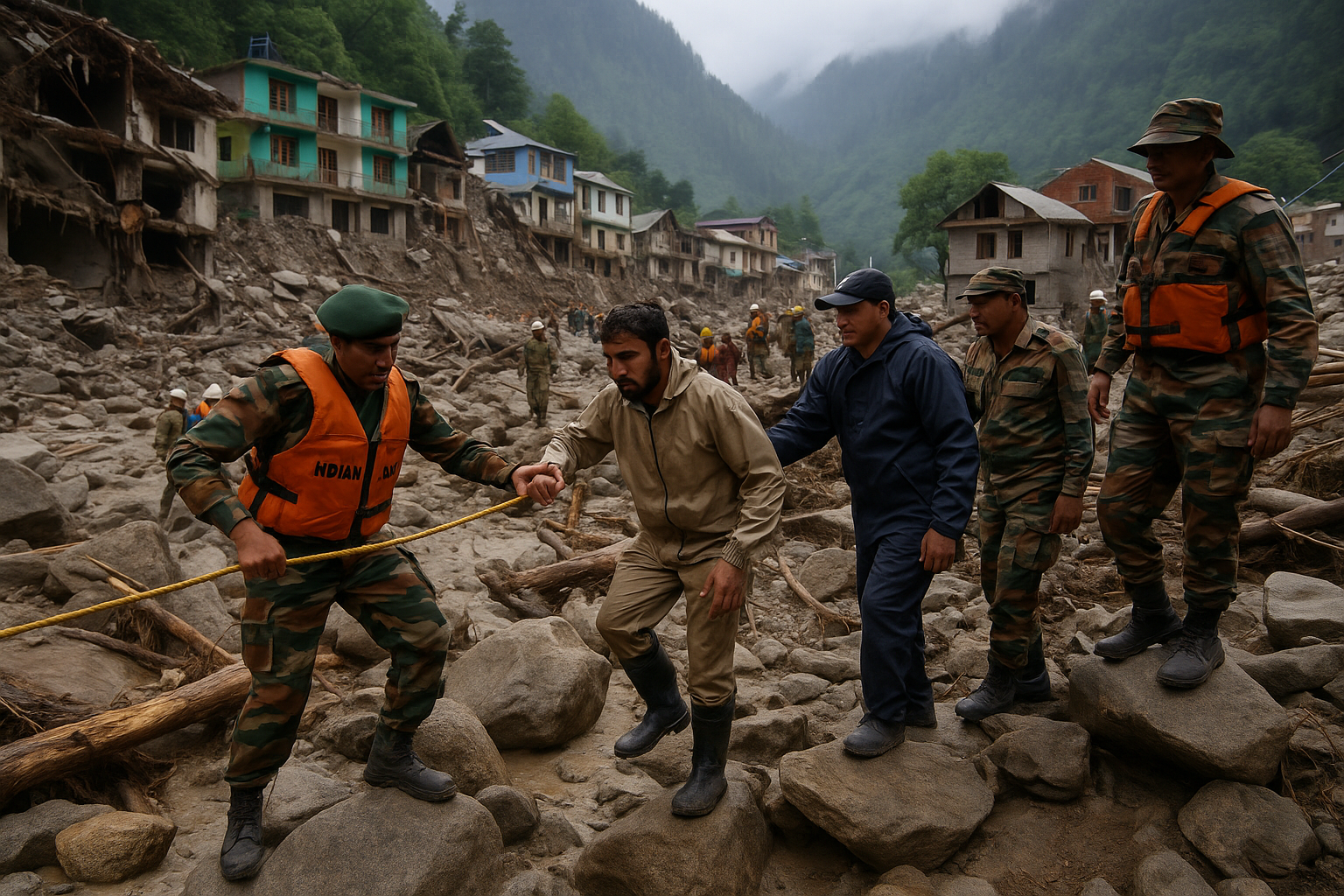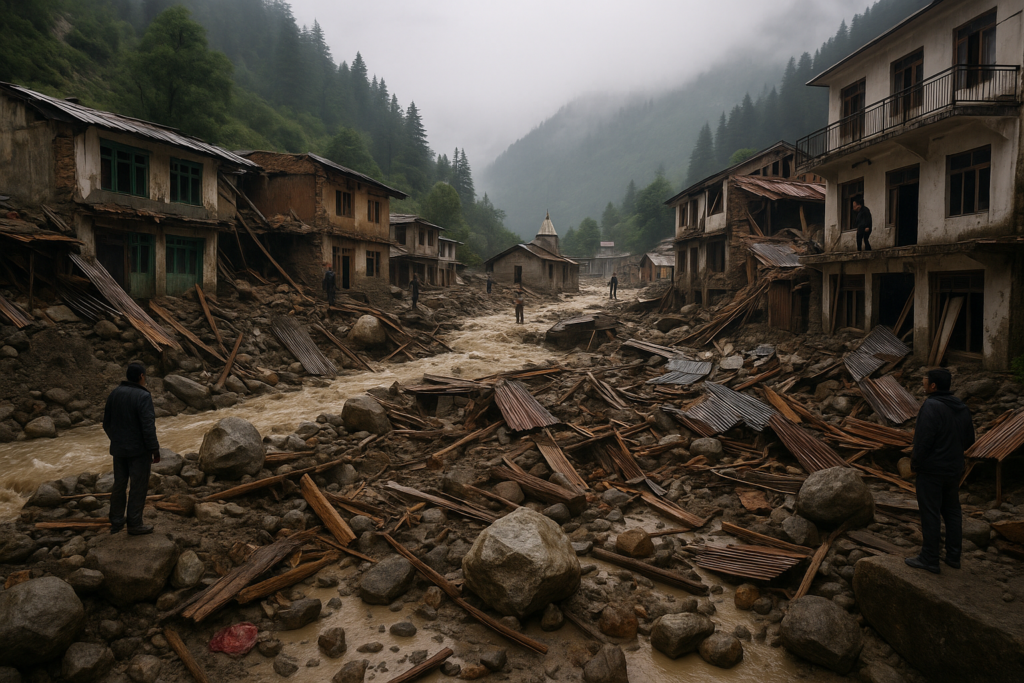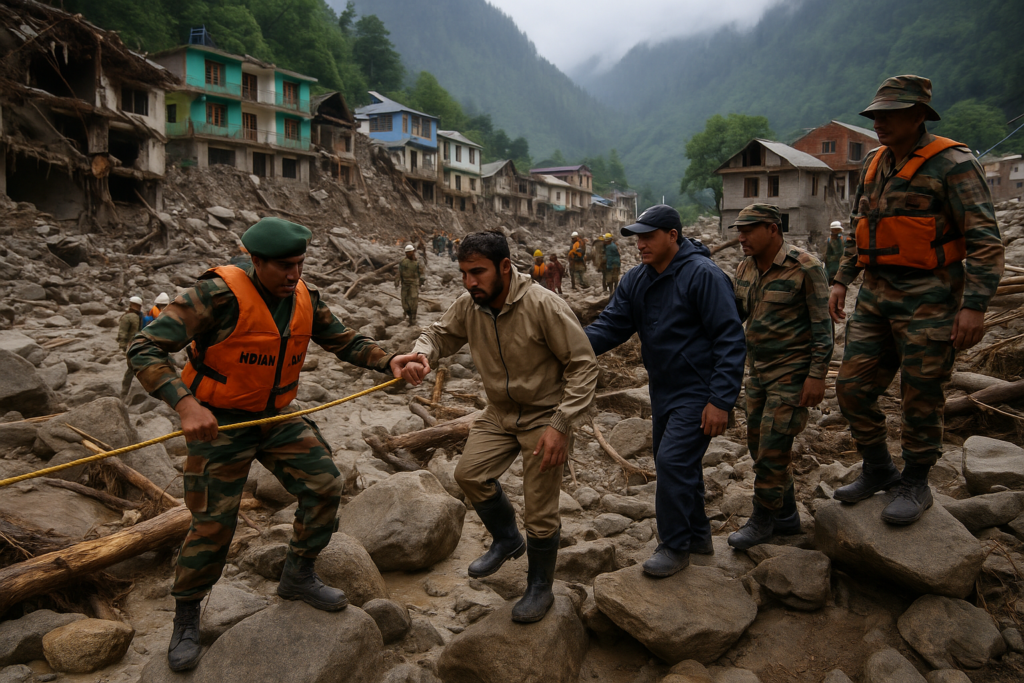Physical Address
304 North Cardinal St.
Dorchester Center, MA 02124
Physical Address
304 North Cardinal St.
Dorchester Center, MA 02124

On August 5, 2025, a peaceful afternoon in Uttarakhand’s Dharali village turned catastrophic. A sudden cloudburst over the upper Kheer Ganga catchment area unleashed a powerful torrent of water, debris, and mud down the slopes into this tiny mountain village nestled near Harsil in the Uttarkashi district. This tragic natural disaster led to the confirmed deaths of four individuals, with more than 50 still missing.
The incident struck at around 1:45 PM, catching villagers and tourists off guard. Within minutes, the flood swept away homes, businesses, and lives. Roads were submerged, communication lines were severed, and panic spread through the region.
Dharali, once a serene village often visited by pilgrims en route to Gangotri Dham, now lies in ruins. According to officials and local media, 20 to 25 structures—including hotels, homestays, local shops, and family homes—have been entirely or partially destroyed. What once buzzed with tourist activity now resembles a disaster zone.
Key damages reported:
With infrastructure wiped out, livelihoods hang in the balance, and recovery will take months, if not years.
As of August 5 evening, four fatalities had been confirmed. Their bodies were recovered by rescue teams from the debris and riverbanks. But the real crisis lies in the over 50 people still missing—a mix of residents, domestic tourists, and workers.
Some were reportedly in their hotels, while others were visiting nearby temples when the disaster struck. Family members are still waiting in hope, clinging to every bit of information from authorities.

Amid the chaos, local residents and tourists shared chilling experiences. Rajesh Rawat, a homestay owner, recalled, “We heard a rumble, like thunder from beneath the earth. Within minutes, water and rocks came crashing down. I grabbed my daughter and ran for higher ground.”
A tourist from Delhi who had arrived just a day before said, “The sky turned dark. It was drizzling and then suddenly, it was like the entire mountain was collapsing.”
These raw stories echo the terrifying unpredictability of Himalayan cloudbursts and how swiftly devastation can follow.
Immediately after the flood, the Uttarakhand State Disaster Response Force (SDRF), Indo-Tibetan Border Police (ITBP), and Indian Army’s Ibex Brigade sprang into action. More than 200 personnel were deployed within hours to comb through the debris and evacuate stranded individuals.
The state government coordinated with central agencies to mobilize relief material, food packets, and emergency shelters.
The Indian Army, known for its mountain warfare expertise, used ropes and ladders to reach trapped villagers. The ITBP, stationed nearby for border duty, played a crucial role in rescuing 37 villagers from isolated areas.
The NDRF teams, trained in swift water rescue, navigated dangerous currents and unstable debris mounds to pull out survivors, often at great risk to their own lives.
Uttarakhand Chief Minister Pushkar Singh Dhami visited the site within hours, stating, “This is a time of great sorrow. Our teams are working round-the-clock to find the missing and restore normalcy.”
Prime Minister Narendra Modi tweeted condolences and assured “every possible support from the Centre.” Relief funds have been released, and compensation for families of the deceased has been announced.

The cloudburst that triggered this disaster occurred over the Kheer Ganga or Kheer Gad catchment, an area known for steep slopes and narrow valleys. According to the India Meteorological Department (IMD), the region received extreme rainfall in a short span—over 70 mm within 45 minutes.
A red alert was issued for parts of Uttarkashi, with warnings of landslides and flash floods extending through August 10. The intensity of the downpour overwhelmed natural drainage systems and caused a massive debris flow, consisting of boulders, mud, and water.
Uttarkashi district lies in the fragile Himalayan belt, where the combination of unstable slopes, glacial melt, and frequent seismic activity makes it highly vulnerable to natural disasters.
Dharali, though scenic, sits along the riverbank of Bhagirathi River, where even slight disturbances upstream can lead to violent downstream flooding. With narrow roads and limited evacuation options, villages like Dharali are tragically exposed to such events.
Experts have long warned that climate change is intensifying the frequency of cloudbursts in the Himalayan region. Warmer temperatures are leading to increased atmospheric moisture, which results in more intense, localized rain events.
Key observations:
Flash floods, once rare, are now alarmingly frequent across Uttarakhand, Himachal Pradesh, and Sikkim.
Uttarakhand has endured a series of devastating natural disasters in the past two decades:
| Year | Disaster | Impact |
|---|---|---|
| 2013 | Kedarnath Floods | Over 5,000 lives lost; thousands displaced |
| 2021 | Chamoli Glacier Burst | 200+ killed or missing; two hydro plants destroyed |
| 2023 | Joshimath Land Subsidence | Dozens of homes evacuated; town deemed “sinking” |
| 2024 | Bageshwar Cloudburst | Flash floods and crop losses across the district |
These recurring events underscore the urgency of comprehensive disaster management in the region.
While Uttarakhand has developed a basic framework for disaster response, the recurring nature of floods and landslides shows that much more needs to be done. The disaster in Dharali has once again highlighted the need for:
Many believe that urban-style development in fragile ecological zones must be re-evaluated to avoid long-term consequences.
In the midst of devastation, numerous stories of courage and resilience have emerged. From ITBP jawans carrying children on their backs, to villagers forming human chains to rescue the trapped, the spirit of togetherness has shone through.
One such hero is Ramesh Negi, a school teacher who saved five people, including a bedridden elder, by breaking through a window and pulling them to safety before his house was swept away.
Uttarkashi, like many parts of the Himalayas, has witnessed unregulated tourism, aggressive road widening, and massive hotel construction. These interventions have disrupted the natural drainage systems and weakened mountain slopes.
Experts argue that unless environmental safeguards are enforced, disasters like Dharali will only become more frequent and deadlier.
The incident has gained international attention, with agencies like Reuters, AP, and BBC highlighting the vulnerability of Himalayan regions to extreme weather events. Social media platforms have seen an outpouring of condolences, calls for help, and climate awareness campaigns.
India’s disaster readiness, climate action plans, and hill-state infrastructure policies are now under global scrutiny.
1. What caused the flash flood in Dharali village?
A cloudburst over the upper Kheer Ganga catchment area triggered a sudden flash flood and landslide, devastating Dharali.
2. How many people are currently missing?
As of the latest reports, more than 50 individuals are still unaccounted for.
3. Are tourists among the missing?
Yes, some of the missing include tourists staying in local homestays and hotels at the time of the flood.
4. What is the government doing to help?
Rescue operations by the Army, ITBP, and NDRF are ongoing. Relief camps, medical aid, and compensation have been initiated.
5. Could this have been prevented?
While cloudbursts are natural, the impact could have been reduced with better warning systems and infrastructure planning.
6. What long-term steps are being considered?
Authorities are discussing reviewing building regulations, expanding warning networks, and restricting unsafe construction in hazard-prone zones.

The tragedy in Dharali is a stark reminder of nature’s unpredictability and the risks of unchecked development. While the rescue operations continue and the search for the missing carries on, what comes next must be smarter planning, stronger safeguards, and sustainable growth.
Dharali will rebuild, but this disaster must serve as a wake-up call for policymakers, builders, and citizens alike. The mountains must be respected, and the people who live among them protected—with heart, with science, and with urgency.